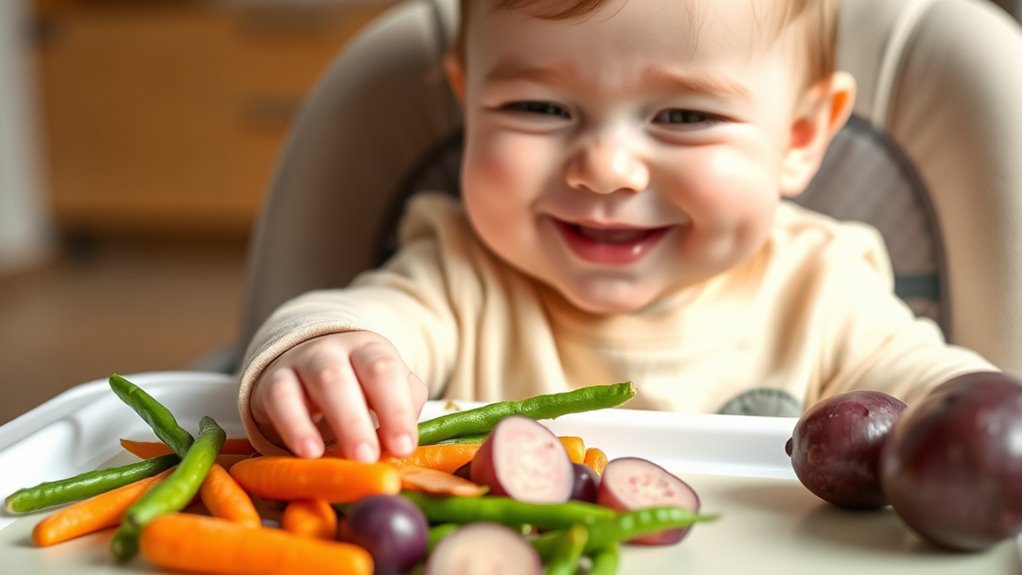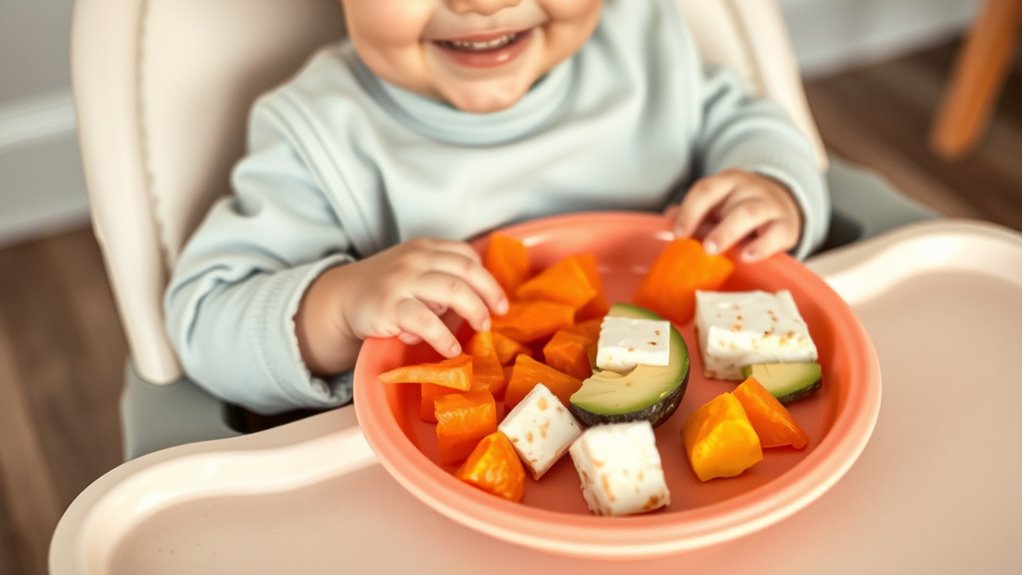Baby-led weaning is a safe, natural way to introduce solids by encouraging your baby to explore self-feeding with soft, age-appropriate foods. It promotes independence, motor skills, and positive eating habits while reducing mealtime stress. Make sure foods are prepared safely, supervise closely, and create a baby-friendly environment. Watch for signs of readiness like sitting steadily and curiosity about food. If you explore further, you’ll find how to support your baby’s confident, safe self-feeding journey.
Key Takeaways
- Begin when your baby can sit steadily and shows curiosity about food, promoting safe self-feeding development.
- Offer soft, cooked foods cut into manageable pieces, avoiding hard or sticky items to prevent choking.
- Supervise mealtimes closely, ensuring the baby is seated upright and using age-appropriate utensils.
- Introduce one new food at a time, monitoring for allergies and reactions during the transition.
- Create a positive, distraction-free environment that encourages exploration, confidence, and independence in self-feeding.
Understanding Baby-Led Weaning: What It Is and How It Works

Have you ever wondered how babies shift from milk to solid foods? Baby-led weaning is a method where your baby explores food at their own pace, using their hands rather than spoon-feeding. Instead of purees, you offer age-appropriate pieces of soft food, encouraging self-feeding. Using suitable feeding utensils, like small, easy-to-handle pieces, helps your baby develop motor skills and independence. It’s important to observe for food allergies during this process, as exposure to new foods can sometimes trigger reactions. Always introduce one new food at a time and watch for any signs of allergies. This approach fosters a positive relationship with food and supports natural development, making mealtimes less stressful and more engaging for both of you.
When to Start Baby-Led Weaning and Signs of Readiness

You’ll want to start baby-led weaning when your little one reaches key developmental milestones, like sitting up steadily and showing curiosity about food. Look for signs that they can grasp and bring food to their mouth independently, which indicates readiness. These cues help verify your baby is prepared to explore new textures and flavors safely.
Developmental Milestones Achieved
Understanding when your baby is ready for baby-led weaning is essential for a smooth shift. Look for these developmental milestones:
- Improved fine motor skills: Your baby can grasp and hold objects, making self-feeding possible. Developing fine motor skills is crucial for successful self-feeding and is supported by their ability to manipulate food.
- Enhanced hand-eye coordination: They can bring food to their mouth with control.
- Strong head and neck control: Sitting upright steadily signals readiness.
- Language development cues: They may respond to your cues or show interest in your food.
- Knowledge of appropriate feeding strategies: Familiarity with diversification techniques can support successful weaning.
These milestones indicate your baby is developing the necessary skills to explore self-feeding safely. Recognizing these signs helps ensure your little one is physically and cognitively prepared for baby-led weaning, reducing frustration and promoting confidence in their eating journey.
Independent Eating Indicators
Recognizing when your baby is ready to start baby-led weaning involves observing specific independent eating indicators that signal their preparedness. Look for feeding cues like enthusiastic reaching for food, sitting unsupported, and showing interest in others eating. Your baby should display self-feeding skills, such as grasping objects and bringing food to their mouth. These signs indicate they’re developmentally ready for self-feeding. Use the table below to identify key indicators:
| Feeding Cues | Self-Feeding Skills | Developmental Signs |
|---|---|---|
| Reaching for food | Picking up food with fingers | Sitting unsupported |
| Showing curiosity about food | Bringing food to mouth | Good head control |
| Opening mouth for bites | Using thumb and forefinger | Interest in family meals |
When these signs appear, it’s time to introduce baby-led weaning safely. Monitoring developmental milestones can help ensure your baby is truly ready for this transition.
Safe Food Choices and Preparation Tips for Your Baby

Ensuring your baby’s safety during weaning starts with choosing the right foods and preparing them properly. To reduce the risk of food allergies and choking, follow these tips:
- Offer soft, cooked foods cut into manageable sizes to prevent choking.
- Avoid foods that are hard, round, or sticky, like whole nuts or grapes, unless sliced thinly.
- Introduce new foods one at a time, watching for any signs of food allergies.
- Always supervise your baby during meals and ensure they’re seated upright to aid swallowing and choking prevention.
- Incorporating appropriate food textures can further support safe self-feeding practices.
Creating a Baby-Friendly Eating Environment

Creating a safe and inviting eating environment helps your baby develop healthy eating habits and enjoy mealtime. Set up a comfortable space with a sturdy, non-slip table and chair suited to your baby’s size. Keep the area free of distractions and clutter to encourage focus on eating. Use simple, baby-friendly feeding utensils—like soft spoons and small bowls—to make self-feeding easier and less messy. Encourage good table manners early by modeling polite behavior, such as sitting calmly and using a gentle voice. Allow your baby to explore their food and utensils without pressure, fostering independence. A positive, organized environment builds confidence and makes mealtime enjoyable for both of you. Incorporating proper feeding techniques can further enhance your baby’s self-feeding skills. Creating a safe space free of hazards and with appropriate supervision ensures your baby can practice self-feeding confidently. Consistency and patience will help your baby feel secure as they learn these new skills.
Recognizing and Responding to Common Challenges

Many parents encounter common challenges during baby-led weaning, such as gagging, food refusal, or messiness. Recognizing these signs helps you respond confidently. Here are some tips:
Understanding common challenges like gagging and food refusal helps parents respond confidently during baby-led weaning.
- Picky eating: If your baby shows food refusal, offer small portions and try different textures or flavors to find what appeals to them. Understanding picky eating patterns can help tailor your approach to feeding.
- Gagging: Gagging is normal initially; stay calm and watch for signs of choking. Encourage slow bites and proper chewing.
- Messiness: Expect messes—use bibs and a washable mat. Stay patient as your baby learns self-feeding skills.
- Food refusal: If your baby refuses certain foods, don’t pressure. Keep offering a variety of healthy options, and they’ll often come around.
- Understanding safe sleep practices can help you create a secure environment for your baby during and after feeding times. Additionally, being familiar with preppy dog names can be a fun way to involve your family in choosing your pet’s identity, making your home environment more lively and engaging.
Supporting Your Baby’s Self-Feeding Journey Safely

Supporting your baby’s self-feeding journey safely means staying attentive to their cues and environment. Establish consistent feeding routines that encourage independence while ensuring your baby feels secure. Watch for signs they’re hungry or full, and avoid pressuring them to eat more than they want. It’s essential to provide a variety of nutritious foods to promote nutritional balance, helping your baby develop taste preferences and healthy eating habits. Keep the feeding area safe and clean, and always supervise mealtimes to prevent choking. Trust your baby’s natural ability to self-regulate intake, and be patient as they explore new textures and flavors. Incorporating Gold IRA Rollovers and practicing patience can also support your baby’s confidence and comfort during this learning process. Being aware of pinball machine weights can help you set up a safe and suitable environment for your baby’s self-feeding activities. Additionally, understanding grocery store hours can be useful if you need to prepare or replenish feeding supplies promptly. Recognizing the importance of symptoms of breast cancer can motivate caregivers to stay vigilant about health signs in themselves and others. By staying alert and responsive, you create a positive, safe environment that supports their growth and confidence in self-feeding.
Frequently Asked Questions
How Do I Handle Gagging During Baby-Led Weaning?
When your baby gags during self-feeding, stay calm and remember gagging safety is key. It’s normal as their gag reflex develops, helping prevent choking. You should never force food or intervene suddenly, as this can increase distress. Instead, observe their reactions, offer small, manageable pieces, and make certain they sit upright. With patience, your baby’s gag reflex will develop, reducing gagging episodes over time.
Can I Introduce Allergenic Foods Early in Baby-Led Weaning?
Imagine your baby happily munching on a piece of peanut butter toast. With allergy awareness and proper food introduction timing, you can introduce allergenic foods early, like peanuts, around six months. Early exposure may reduce allergy risks, but always consult your pediatrician first. By carefully timing and monitoring, you help your baby explore new flavors safely, setting the foundation for diverse, healthy eating habits.
What if My Baby Refuses Certain Textures or Foods?
If your baby refuses certain textures or foods, don’t worry. It’s normal for babies to have texture preferences and go through phases of food refusal. Try food refusal strategies like offering small portions, staying patient, and repeatedly introducing new textures without pressure. You can also gently mix preferred and less-liked textures or try different presentation styles to encourage acceptance. Keep offering, and over time, their preferences may expand.
How Do I Ensure My Baby Gets Enough Nutrients?
While it may seem intimidating, you can guarantee your baby gets enough nutrients by offering a variety of foods rich in nutrient density. Balance colorful fruits, vegetables, proteins, and grains to cover essential vitamins and minerals. Even if your baby refuses some textures, keep introducing new tastes and textures regularly. This approach promotes a well-rounded diet, helping your little one thrive while exploring self-feeding and developing healthy eating habits.
Is Baby-Led Weaning Suitable for Preemies or Babies With Health Issues?
You might wonder if baby-led weaning suits preemies or babies with health considerations. It can be safe, but you should consult your pediatrician first. Preemie feeding and health issues require tailored approaches, so they might need modified textures or timing. Always follow professional advice to guarantee your little one gets the proper nutrients and avoids choking risks. With proper guidance, baby-led weaning can be adapted to support your baby’s unique needs.
Conclusion
As you guide your little one through baby-led weaning, remember you’re planting seeds of independence and confidence. Each meal is a gentle bridge between infancy and self-discovery, like a tiny boat sailing into new waters. Trust your instincts and cherish these moments of exploration. With patience and love, you’re nurturing a lifelong love of food—one bite at a time—transforming mealtimes into a journey of growth and joy.










